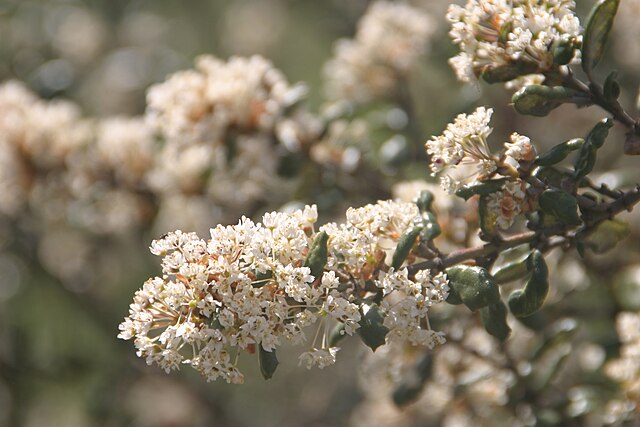Hoaryleaf Ceanothus
(Ceanothus crassifolius)
Hoaryleaf Ceanothus (Ceanothus crassifolius)
/
/

Joe Decruyenaere
CC BY-SA 2.0
Image By:
Joe Decruyenaere
Recorded By:
Copyright:
CC BY-SA 2.0
Copyright Notice:
Photo by: Joe Decruyenaere | License Type: CC BY-SA 2.0 | License URL: http://creativecommons.org/publicdomain/zero/1.0/deed.en | Uploader: Z3lvs | Publisher: Wikimedia Commons |













Estimated Native Range
Summary
Ceanothus crassifolius, commonly known as hoaryleaf ceanothus, is an evergreen shrub native to the chaparral and coastal sage scrub of California and Baja California. It is well-adapted to dry, rocky slopes and canyons within these ecosystems. The shrub typically grows to a height of up to 10 feet with a similar spread, featuring small, leathery leaves that have a distinctive hoary texture due to fine hairs. From late winter to early spring, it produces dense clusters of tiny, fragrant white flowers that are highly attractive to pollinators such as bees and butterflies.
Hoaryleaf ceanothus is valued for its drought tolerance and ability to stabilize slopes, making it an excellent choice for erosion control in xeriscaping. It is also used in habitat restoration projects and as an ornamental in native plant gardens. This shrub thrives in full sun to partial shade and prefers well-drained soils. While it is generally low-maintenance, it can suffer from root rot if overwatered. It is also susceptible to fungal diseases in humid conditions. Hoaryleaf ceanothus does not transplant well due to its deep root system, so it is best to plant it in its permanent location from the start.CC BY-SA 4.0
Hoaryleaf ceanothus is valued for its drought tolerance and ability to stabilize slopes, making it an excellent choice for erosion control in xeriscaping. It is also used in habitat restoration projects and as an ornamental in native plant gardens. This shrub thrives in full sun to partial shade and prefers well-drained soils. While it is generally low-maintenance, it can suffer from root rot if overwatered. It is also susceptible to fungal diseases in humid conditions. Hoaryleaf ceanothus does not transplant well due to its deep root system, so it is best to plant it in its permanent location from the start.CC BY-SA 4.0
Plant Description
- Plant Type: Shrub
- Height: 7-12 feet
- Width: 7-12 feet
- Growth Rate: Moderate
- Flower Color: White
- Flowering Season: Spring
- Leaf Retention: Evergreen
Growth Requirements
- Sun: Full Sun
- Water: Low, Medium
- Drainage: Medium
Common Uses
Bee Garden, Bird Garden, Butterfly Garden, Drought Tolerant, Low Maintenance, Showy Flowers
Natural Habitat
Chaparral and coastal sage scrub, dry rocky slopes, and canyons
Other Names
Common Names: Hoary Ceanothus , Thickleaf Ceanothus , Thickleaf Wild Lilac , Hoary Buckbrush
Scientific Names: Ceanothus crassifolius , Ceanothus crassifolius var. planus , Ceanothus verrucosus var. crassifolius
GBIF Accepted Name: